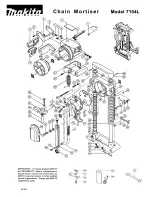
POWX0561
EN
Copyright © 2018 VARO
P a g e
|
10
www.varo.com
Note:
To prevent the saw from kicking back during plunge cuts follow these steps:
▪
Always place the plunge saw with the rear edge of the base plate (5) against a fixed limit
stop.
▪
Hold the plunge saw in both hands and slowly lower the saw blade.
▪
The cutting width marks (15) show the most foremost and rearmost cutting points of the
saw blade (Ø 165 mm) at maximum cutting depth and when using the guide rail.
10.9
Replacing the saw blade
Before any maintenance work always switch off the plunge saw and
disconnect from mains power.
▪
Loosen both rotary knobs (8) and swivel the plunge saw to 0° position before changing the
saw blade. Tighten the rotary knobs again.
▪
Set the selector switch (17) to the change saw blade icon.
▪
Press the switch lock (2) down and push the motor down.
▪
Press and hold the spindle arrester down.
▪
Use a 5 mm Allen key to turn the screw at the saw blade slightly clockwise or counter-
clockwise until the spindle clicks into place.
▪
Use the Allen key to loosen the screw counter-clockwise. Remove the outer flange and the
saw blade.
▪
Clean both flanges and replace the saw blade.
Note:
The rotation direction arrows of saw blade and saw must be aligned!
▪
Replace the outer flange in such way that the slaving pins sit in the recesses of the inner
flange.
▪
Press and hold the shaft lock b utton and tighten the screw. Press the switch lock (2) for
the casing to swivel up again.
11 FINE ADJUSTMENT OF PLUNGE SAW PLAY ON GUIDE RAIL
The play of the base plate on the guide rail can be reduced to minimum with the fine
adjustment screws (7).
▪
Loosen the fine adjustment screws counter-clockwise.
▪
Turn both fine adjustment screws (7) clockwise to minimize the play between base plate
and guide rail, if necessary.
▪
Fasten the fine adjustment screws clockwise.
12 CONNECTING RODS FOR GUIDE RAILS (FIG. 7)
▪
To connect both guide rails slide the first connecting rod from the bottom into the groove of
the guide rail.
▪
Slide the other connecting rod into the second groove.
▪
Use the 3 mm Allen key to tighten the stud screws to the limit stop to connect the rails.
13 GUIDE RAIL SPLINTER GUARDS (FIG. 8)
The guide rails come with a splinter guard (black protruding rubber lip). The splinter guard
should be cut to size before first use. The splinter guard ensures a tear-free cut, since the
wood fibers at the top of the work piece are torn without splinter guard. This is due to the saw
blade teeth being directed upward.
After cutting the splinter guard to size it also shows the precise cutting path of the saw blade.
▪
Mark a cutting line on the work piece and align the guide rail exactly with this cutting line.
































